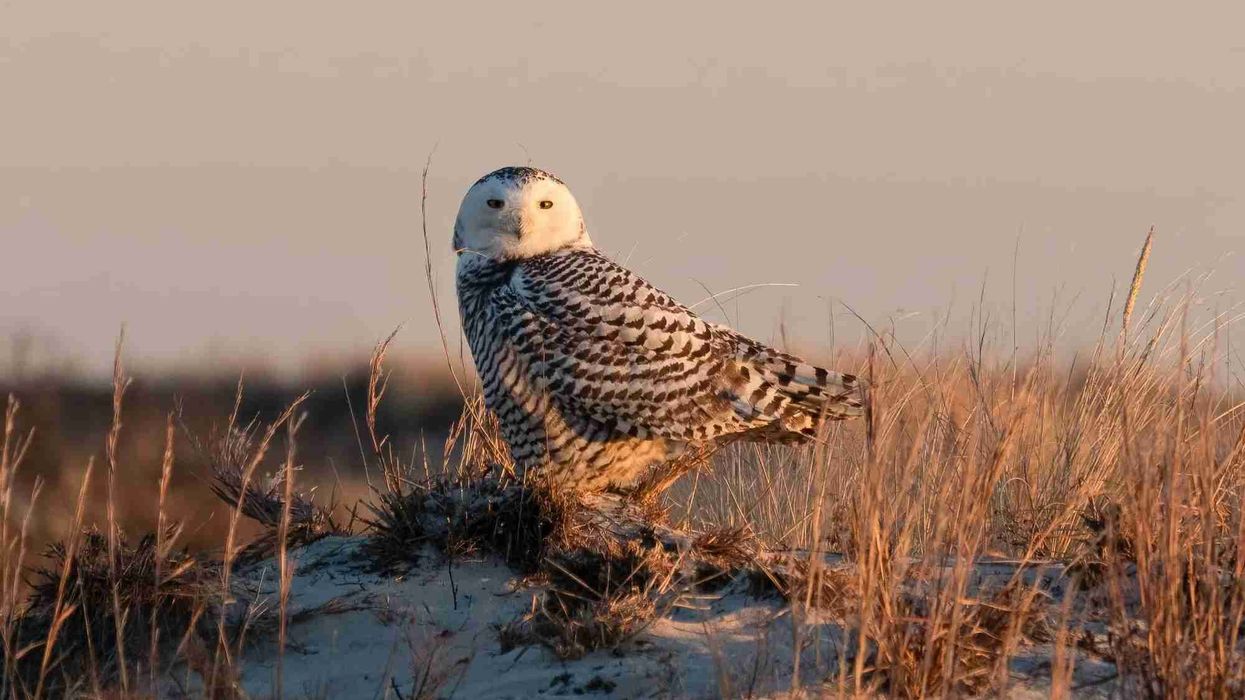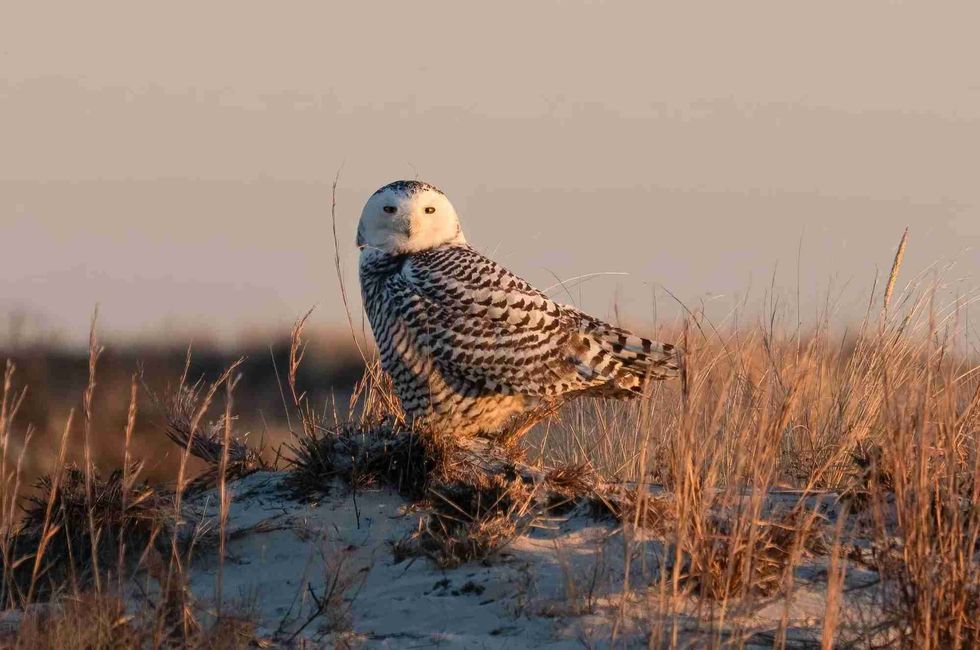Most of us have watched or read about Hedwig, the snowy owl in the Harry Potter books. Hedwig is a snowy owl who played a crucial role in Harry’s life.
Snowy owls belong to the family of Strigidae or 'true owls'. It is one of the two recognized owl families, the other one being the Tytonidae or barn owls.
Snowy owls are identified for their white plumage and it becomes evident behind the origin of their name. They are native to North America, the Arctic, and Palearctic.
This bird is nomadic and was first described by Carl Linnaeus in 1758. The scientific name of the snowy owl, Bubo scandiacus, is a combination of two Latin words. ‘Bubo’ translates to 'horned owls' while scandiacus is 'Scandinavia' in New Latin.
Snowy owls were formerly placed under the genus Nyctea but recently it was discovered that the snowy owls have closely linked to the horned owls of genus Bubo. These are large owls and are widely referred to as Arctic owl, white owl, or Polar owl.
Recently, the population of this exotic owl species has declined due to human activities and habitat loss. The Snowy owls are now contemplated as a vulnerable species.
Intrigued already? Want to learn more about the snowy owls? Then keep reading this article as more interesting facts are stated below.
If you find this article interesting then check our other articles on short-eared owl facts and quetzal facts and share these amazing facts with everyone.
Snowy Owl Interesting Facts
What type of animal is a snowy owl?
Snowy owls are large owls native to the Arctic, Palaearctic, and North American region and are recognized for their feathers.
What class of animal does a snowy owl belong to?
The snowy owl or Bubo scandiacus belongs to the class of Aves, of order Strigiformes, family Strigidae, and genus Bubo. Previously placed under the genus Nyctea and now Bubo these owls are related to the Horned owls.
How many snowy owls are there in the world?
The population of the snowy owls has declined as a result of human activities and habitat loss. There was over 200,000 present all over the world that has reduced to half of what the population used to be.
A recent survey has estimated that only 100,000 individuals are left out of which 28,000 are potential breeding pairs that can be found globally.
Where does a snowy owl live?
The snowy owls are nomadic birds with a wide geographical range, and their range may vary accordingly. These are the native Arctic and North American birds which have distinct breeding and wintering range as they are very adaptable.
The wintering range of this species incorporates Russia, the British Isles, Iceland, Central Europe, the northern region of China, and very rarely in eastern European countries and Mediterranean territories and winter can be associated with regions of the Bering sea.
The breeding range of this bird is greatly influenced by the presence of lemmings particularly and other mammal species as well.
Breeding is primarily done in Tundra.
The snowy owls can be found near Northern Russia, Scandinavia, even in the North of Greenland. Besides these places, these birds can be observed in the North American ranges including the western Aleutians, Bering Sea, and from Northern Alaska till Ellesmere.
What is a snowy owl's habitat?
The snowy owl's habitat also depends on the breeding and nonbreeding status of the bird. The breeding habitat of this bird is the open Tundra of the Arctic where there are plenty of lemmings and a wide variety of small mammals to survive.
These birds select low prominences as their nesting, and roosting sites. The non-breeding habitat of these birds includes farmlands, marshes, coastlines, ice packs, cities, towns, and any kind of open habitat.
Who do snowy owls live with?
Snowy owls are solitary birds and can be territorial particularly during the mating season when the males act very territorial. These birds are mostly seasonally monogamous.
How long does a snowy owl live?
The average lifespan of a snowy owl in the wild is 10 years or more, but in captivity, this bird can live as long as 28 years.
How do they reproduce?
The Snowy owls are chiefly seasonally monogamous and the male snowy owls can be territorial during the season. In their breeding range, the males display many gestures like singing and frequently plunge to the ground and fly again.
The male is seen carrying lemmings as an offering and then it bows with this tail cocked up. After these, the male also flaps his wings continuously for about five minutes. The female may refuse to mate if all the above circumstances are not met.
However, the method of reproduction is copulation. After copulating the females arrives at the nesting site by April or May and lay around 7-9 eggs.
What is their conservation status?
The conservation status of the snowy owl is Vulnerable according to IUCN as the population of this bird has gone down drastically leaving only half of its population around the world. Although the snowy owls are extremely adaptive yet various factors are responsible for their vulnerable status such as habitat loss due to global warming.
As the population of snowy owls also depends on the lemming population as their food source is diminishing and so is their population. Besides this, The snowy owls are often killed by cars and powerlines.
These birds are also hunted for their claws and unusual yellow eyes. Besides humans, the major Snowy owl predator is wolves and even foxes.
Snowy Owl Fun Facts
What do snowy owls look like?

The snowy owl is rarely misidentified because of its unique features. Snowy owls are large owls and the length of this bird is approximately 20.7-25.2 in (52.5-64 cm).
These birds have white plumage and the feathers of the male snowy owls are whiter than the females. The ear tufts of this bird are around 0.79-0.98 in (20-25 mm) and have small feathers. The Snowy owl face is completely white.
The females are more spotted than the males and their underparts and crows are slightly barred. Also, their feet have thick feathers and their claws are black.
How cute are they?
These white owls look like snowballs and therefore they are extremely cute.
How do they communicate?
The snowy owl's call is called hooting just like other owls. The males are frequently seen singing as a form of courtship before mating. These birds may also hiss, whistle, and sometimes clap their beaks.
How big is a snowy Owl?
The size of a snowy owl is approximately 20.7-25.2 in (52.5-64 cm). It is slightly bigger than the great horned owl which is approximately 25 in (60 cm) in length.
How fast can a snowy owl fly?
These birds are highly migratory and adaptable. It can be observed flying over the Tundra, Arctic during some part of the year, and sometimes with North American birds during the other time of the year. The speed of this bird is determined to be 46 mph (74 kph).
How much does a snowy owl weigh?
The weight of the males is 2.9-5.5 lb (1.3-2.4 kg ) and females are 2.9-6.5 lb (1.3-2.9 kg).
What are the male and female names of the species?
There are no sex-specific names that have been assigned to the male and female of this species of bird. A male bird is called cock and a female bird is called a hen in general.
What would you call a baby snowy owl?
A baby owl is called an owlet or a chick. After mating successfully the female flies to the nesting site where she lays 7-9 eggs.
What do they eat?
The snowy owl's diet consists of small mammals, fishes, passerine birds, and insects. The population of these birds largely revolves around the accessibility of their food. The primary food source is lemmings and if not that then other wide variety of rodents.
Are they dangerous?
These birds can be territorial however no such incident of them being dangerous has been reported.
Would they make a good pet?
Harry may have Hedwig, but it is not advised to keep a snowy owl as a pet because this species is vulnerable. the population of this bird is already declining hence captivating them without any purpose is not correct.
Did you know...
Owls are nocturnal and are active during the night, but snowy owls can be observed actively flying during the day, particularly during summer.
An adult snowy owl can eat three lemmings each day.
The snowy owl rarely breeds in the same location twice.
The snowy owl's adaptations
The snowy owls are extremely adaptable as they can adapt themselves to any kind of climate be it the harsh winter of the Arctic or Tundra. The thick feather of this bird enables them to trap heat and protect them from the shivering cold.
The snowy owl prey on lemmings predominantly but they can also survive on other creatures including passerines, ducks, even fishes, and insects. They are nomadic birds and their range relies on the availability of food.
The symbolism of the snowy owl
Snowy owls, or white owls, have symbolic meanings in various cultures. In Native American culture, the white owl can be associated with protection and power. If you see a white owl it can be thought of as an indication of change, transformation, and wisdom.
Here at Kidadl, we have carefully created lots of interesting family-friendly animal facts for everyone to discover! For more relatable content, check out these burrowing owl facts and Rufous owl facts pages.
You can even occupy yourself at home by coloring in one of our free printable pearl spotted scops owlet bird coloring pages.









